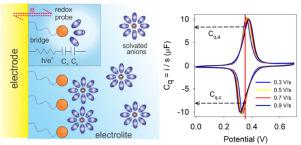Electrochimica Acta ( IF 5.5 ) Pub Date : 2021-09-09 , DOI: 10.1016/j.electacta.2021.139219 Erika Viviana Godoy Alarcón 1 , Adriano Santos 1 , Paulo Roberto Bueno 1

|
It was recently shown that the electron transfer rate constant of an electrochemical reaction and the conductance quantum are correlated with electrochemical capacitance [1]. The association of these two separate concepts has an entirely quantum rate basis that encompasses the electron transfer rate theory as originally proposed by Rudolph A. Marcus [2]. Presently, we demonstrate that this quantum mechanical rate principle can be used to calculate the electron transfer rate constant of a diffusionless heterogeneous electrochemical reaction by taking a specific value of the current–voltage electrochemical curve. The latter is possible because the quantum of conductance is related to the quantum capacitance such that it follows specific electron spin (up and down) and redox state degeneracy rules. Once these rules are settled in the general definition of the quantum rate, the rate of electron transfer is observed to be solely a function of an experimentally measurable quantum capacitance, thus establishing a simple methodology for measuring the electron transfer rate constant. The calculated value of the electron transfer rate is, within the experimental error, in agreement with traditional methods.
中文翻译:

量子电化学的观点。一种测量电子转移速率常数的简单方法
最近表明,电化学反应的电子转移速率常数和电导量子与电化学电容相关 [1]。这两个独立概念的关联具有完全的量子速率基础,包括 Rudolph A. Marcus [2] 最初提出的电子转移速率理论。目前,我们证明了这种量子力学速率原理可用于通过采用电流-电压电化学曲线的特定值来计算无扩散非均相电化学反应的电子转移速率常数。后者是可能的,因为电导量子与量子电容有关,因此它遵循特定的电子自旋(向上和向下)和氧化还原状态简并规则。一旦在量子速率的一般定义中确定了这些规则,就可以观察到电子转移速率仅仅是实验可测量的量子电容的函数,从而建立了一种用于测量电子转移速率常数的简单方法。电子转移率的计算值在实验误差范围内,与传统方法一致。











































 京公网安备 11010802027423号
京公网安备 11010802027423号